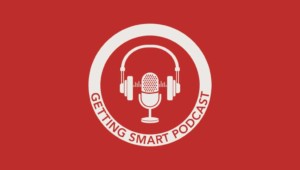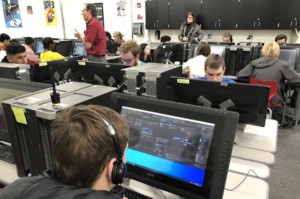Holacracy: Organizing For Change At District 51

A version of this blog ran on CompetencyWorks as the fourth in a blog series sharing Mesa County Valley School District 51‘s journey as it shifts to a competency-based education model (D51 uses the phrase performance-based learning).
Posted inside the conference space at Mesa County Valley School District 51 (D51) is a Managing Complex Change chart describing the conditions for successful change implementation. It identifies five elements to consider (vision, skills, incentives, resources and action plan) and five results if any are not well-managed (confusion, anxiety, resistance, frustration and false starts).
 Although the chart is very simple, it does provide language and concepts that jumpstart conversations around identifying if something isn’t working well. For example, in a leadership meeting I attended at D51, I heard someone say, “I don’t want to false start them by putting them in a meeting that is too deep in the weeds,” referring to not having a formal plan to introduce new ideas. In other meetings, attention was given to possible anxiety and angst if teachers don’t have the chance to access supports based on where they are in their own learning.
Although the chart is very simple, it does provide language and concepts that jumpstart conversations around identifying if something isn’t working well. For example, in a leadership meeting I attended at D51, I heard someone say, “I don’t want to false start them by putting them in a meeting that is too deep in the weeds,” referring to not having a formal plan to introduce new ideas. In other meetings, attention was given to possible anxiety and angst if teachers don’t have the chance to access supports based on where they are in their own learning.
But how do you make sure that vision + skills + incentives + resources + action plan are all in place and all aligned to bring change? D51 knows, as pretty much any district leadership involved in the conversion to competency education knows, that top-down hierarchical structures aren’t helpful. They force decisions to the top when what we want is to create empowering, flexible organizational structures.
So what’s a district to do? D51 is testing out if holacracy will do the trick.
What Is Holacracy?
D51 isn’t comfortable just saying that the district is going to be more supportive. They aren’t comfortable just saying that transformational leadership strategies are important. They are seeking to replace the bureaucratic organizational culture and structure with a holacratic one (the management approach used by Zappos).
Holacracy is a system for self-organizing so that as context changes, so can the organization. There are a few key pieces to this model:
1. It assumes a highly flexible organizational structure that will change as needed.
2. It depends on clarifying roles and scoping out their realm of autonomy and authority. In other words, individuals and teams know that they are empowered to act.
3. It clarifies intersections or cross-links. When a Team, referred to as Circles, wants to act, it needs to engage the other intersecting circles.
4. Meeting protocols are important. There are two kinds of meetings with two different protocols: governance (who is doing what) and tactical (what are we going to do). Agendas are created right there in the meeting so that everyone contributes. No one can control the agenda. There is a brief presentation of the tension and solution with an opportunity to amend and clarify. Members are then asked to raise a hand if there is an objection. The objection is discussed and resolved, and then it’s on to the next agenda item. There is little room for personal issues, turf-battles or power dynamics as everything is happening real-time. If there is a problem, everyone revisits the domain (scope) and authority.
A software platform supports the holacratic structure in staying focused and communicating decisions. There are several different views, including a personal one, with the overall organizational structure of my circles, my roles, my projects, my tensions (issues you are trying to resolve) and my authority.
Essentially, holacracy is designed to tap into the knowledge of an organization by bringing together multiple perspectives without falling into the trap of the most powerful dominating what rises to the top of agendas and how it is interpreted. We all know how organizations create a dynamic and narrative that is difficult if not impossible to penetrate. Holacracy is designed to let the organization breathe so that it can seek ways to act in ways that are more aligned with the espoused values and vision.
While at D51, I sat in two meetings using the process. It definitely feels awkward (one person described it as “appropriately uncomfortable”), but not as awkward as sitting through a meeting where no decisions are being made. Superintendent Stege Schultz explained, “Our previous top-down structures for decision-making and communication often resulted in no decisions and miscommunication. There were a lot of meetings and everyone was advocating for their own agenda. We weren’t being driven by a shared vision. In the holacratic model, we focus on the work and our roles, not personalities. ”
The holacratic protocols also don’t prevent districts from putting their values first. A few days after a student tragically took his life, the opening process of checking in (What’s on your mind? What you want to get done this week?), which was designed to be a rapid go-around, was instead heartfelt, as slow as it needed to be and wrapped the group in love.
How Is Holacracy Being Implemented In D51?
One important thing to remember is that whatever is described here may change, even as early as tomorrow if D51 finds that the form of the structure isn’t meeting their needs.
Coordinating Council: The purpose of the Coordinating Council (CC) is to design and align operations, ensure efficiency among the supporting Teams and solve problems that arise. It also defines clearer lines for communication. The President of Mesa Valley Education Association sits on the CC as part of the district leadership.
Superintendent Steve Schultz emphasized, “ Partnerships and relationships are important to successful adaptive change. We are growing our system to be agile and responsive. Representation from the Mesa Valley Education Association and feedback loops to other employee groups are critical components of our Coordinating Council.” Individuals have a responsibility to bring items forward to the CC, but always with a suggestion for solving the problem. Each member of the CC is on at least one other circle. Everyone remains empowered.
The focus is on topics that might impact the entire system. The CC wants to be able to identify trends that are emerging early on so they can address them quickly. The CC also keeps an eye on governance to ensure that all Circles are working well, with the right people, with the right scope and with the right authority.
Teams (Sometimes Referred to as Circles): There are as many teams as are needed. For example, in shaping their circles, D51 has established a School Leadership Support Team that is focused on the instructional leaders in the schools. They’ve removed compliance and complaint issues from their scope of work so they can stay focused on improving the quality of instruction throughout the district (complaints now go to the Advocacy and Support Team).
Teams include Advocacy and Support (complaints and compliance); Budget and Financial; Learning Systems Design; School Leadership; Community and Family Connections; Human Resources; Support Services; Student Support Services; and Technology. Please note, the size of the circles below reflect defined roles and do not suggest greater influence or importance.
The team leading much of the design work for the new PBL system is the Learning System Design Team. Each team uses the same meeting protocols for governance and tactical issues. D51 is in the process of trying to identify the need for cross-links and the people who will take responsibility for ensuring two-way dialogue. Eventually, they will each have leading indicators to monitor their work.
Below are a few example of the types of topics discussed at the Coordinating Council:
- A key staff person is out on extended leave. Should someone replace her and have the same domain and authority so that decisions can continue to get made?
- There are many people engaged in the design processes underway but many of them had not been formally assigned to major circles. How are they getting information? Are they clear about their domains and accountabilities?
- The Assessment Circle is operating in isolation rather than as a sub-circle or with cross-links to broader Teaching and Learning Framework. Should a sub-circle be organized?
- D51 has been participating in a school climate survey pilot. Do they trust the data? Is the data available in a timely fashion? Do they have a way to use it? If not, do they want to expend resources on it?
Why Holacracy?
Superintendent Schultz knew he needed a different way to manage the district but didn’t know exactly what it was–until he discovered the concept of holacracy in small font in the midst of KnowledgeWorks’ Future of Learning. “We know that districts have formal ways of handling issues…and then there are all the informal ways. They may help resolve issues in the short run, but they also undermine trust. Trust is an invaluable quality we need for change and for educating children. We need mechanisms that build trust.”
Schultz also said that the values of holacracy are highly compatible with D51’s values, which are shaping the transformation process and that of performance-based learning. “We don’t have anything to hide,” he said. “Just as transparency is an important quality of performance-based learning, so too are we trying to model transparency in everything we do, including decision-making.”
Schultz describes the difference between the bureaucratic processes and the holacratic processes as the speed and quality between a farm horse and a thoroughbred stallion. So the question is, can holacracy expedite the process of converting districts to personalized, performance-based systems?
Building Leadership Skills
“Autonomy and accountability are an important part of how holacracy works. When people discover problems they have a responsibility to bring it to their team leader or the Coordinating Council,” said Shultz. “If you discover a problem and do not raise it, the question then becomes about clarifying your scope and authority. If the problem is an issue of skill, we can help people build the skills they need.”
D51 is engaging leadership in the district and at the school level in thinking about the leadership and communication skills they need. They are using Liz Wiseman’s book Multipliers to increase awareness and choice about the type of leadership they use. As always, they aren’t throwing the baby out with the bathwater. They’ve been using an Organizational Health Improvement tool for years to provide management feedback. Now they are cross-walking the four types of language choices – calibrating, consulting, collaborating and coaching – across the diminisher and multiplier traits described below.
Virgel Hammonds of KnowledgeWorks introduced the D51 team to Multipliers. It’s an interesting model, as the six diminisher traits all sound pretty good: The Rapid Responder (moves fast with decisions); The Rescuer (solves other people’s problems); The Optimist (always looks on the positive); The Pacesetter (sets high standards for quality and pace); the Idea Guy (presents ideas first to stimulate others): and the Always On (infectious energy and points of view). But when you think about the impact on others, you realize that they are likely to be causing unproductive reactions, failing to build trust, failing to empower others and failing to deal with the challenges at hand.
The multiplier traits are all designed around empowering others, building knowledge and developing more leadership: The Liberator (creates space to think, speak, and act); The Challenger (seeds the opportunity, lays down the challenge); The Talent Magnet (finds people’s native genius, utilizes them to their fullest); The Debate Maker (frames the issue, sparks the debate, drives a sound decision); and The Investor (defines ownership, invests resources, holds people accountable).
Of course, the real trick is that for each of the traits, it’s best to become skilled in all of them and know which one will be most suitable to the situation at hand.
For more, see:
- Growing Into The Framework: A District’s CBE Implementation Strategy
- The Vision of Performance-Based Education at District 51
- Building Community Consensus for District Change
- Getting Smart Podcast | District 51 On Building a Performance-Based Education System
Stay in-the-know with all things EdTech and innovations in learning by signing up to receive the weekly Smart Update. This post includes mentions of a Getting Smart partner. For a full list of partners, affiliate organizations and all other disclosures please see our Partner page.







0 Comments
Leave a Comment
Your email address will not be published. All fields are required.